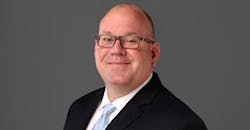Video Highlights from SLC 2020: Answering the Call
In the words of Dr. Jay Harf, vice president of EHS&S with global cosmetics manufacturer L’Oréal, “2020 has been a VUCA year—volatile, uncertain, complex and ambiguous.” Harf was one of the keynote speakers at our recent Safety Leadership Conference 2020, which was held virtually this year. Fittingly, Harf’s presentation focused on how everything changed by necessity during this pandemic-dominated year. But he also emphasized that, for safety leaders, nothing really changed at all.
As the leader of the EHS&S zero incident culture for the L’Oréal Americas Zone, Harf oversees more than 8,000 employees across 39 manufacturing and distribution centers. His group was tasked with implementing 222 criteria with 33 directives on how to protect L’Oréal’s employees from COVID-19. Just like his safety professional peers, Harf has acquired a lot of new job responsibilities over the past year—quarantines, density studies, industrial hygiene, social distancing, thermal imaging, work-from-home protocols, new e-learning training procedures, and contact tracing, just to name a few.
“It’s because of you—the safety professionals—that we’ve been able to succeed with what’s happening in the VUCA world,” Harf told the SLC attendees. “We’ve done a lot of things to protect ourselves and our employees in our own personal COVID experiences, but now we’re being asked: can we do more?”
Safety professionals everywhere, he pointed out, have been called on to protect everyone—and not just their physical safety, but their emotional safety as well. “That is the path forward for safety professionals: to guarantee not only the health and safety of our people physically but also emotionally and psychologically. This will be critical to our success in the future.”
As he sees it, on a symbolic level, the most important PPE of our lifetimes is the face mask, and it’s also been the most polarizing, with some people to this day still asking why they have to wear a mask. What makes safety professionals different from the rest of the world—and of course, everybody has an opinion on the COVID-19 virus—is that they make decisions based on research and risk management. And ultimately, safety leaders are validated by those decisions.
For instance, Harf cited a recent study by the University of California, Davis that states, “Wearing a mask can reduce the risk of infection to the wearer by 65%, and social distancing reduces the risk of transmitting the virus by 90%.”
“This is how we determine our path forward as safety professionals,” Harf emphasized. “We understand the risks, we implement controls, and we protect our people.”
Every time the world has needed help from the EHS community this year, safety professionals have delivered, he said, “because that’s how we were made. Because we are people who care about others above all else. That’s what has shaped our careers, and that’s what’s given us the spirit of continuous improvement.”
So you might think that, at this point, with all the additional responsibilities EHS professionals have taken on and with COVID-19 turning the business world virtually upside down, Harf would be perfectly justified in saying that safety leaders have gone above and beyond the call of duty in 2020. But that’s exactly what he didn’t say.
The only thing that’s really changed, he said, is that people in positions of authority—from the C-suite to politicians to the healthcare industry—as well as people in all walks of life around the world are now, finally, paying close attention to EHS professionals and are noticing the difference that safety leaders are making. But as for safety leaders themselves? It’s just been business as usual. “We’ve always delivered results, and we’ll continue to deliver and take care of people because that’s what we do.”
So how have safety leaders evolved during this VUCA year to end all VUCA years? The simple answer, Harf said, is that safety leaders didn’t evolve at all. The idea of a workplace safety culture isn’t new at all, nor is the work ethic of safety professionals constantly improving themselves through training and certification and networking with peers. EHS leaders have always had a vision of safety excellence—that, in fact, is what defines them.
In short, Harf said, “We didn’t evolve. We got better.”
And as 2020 mercifully comes to an end and we look forward to a hopefully much brighter 2021, I want to extend a great big “THANK YOU” to you—the safety leaders in organizations both big and small—for your service to your employees, your communities and the world at large. Have a happy, healthy and safe New Year!
EHS Today Intelligence members can watch Jay Harf's full SLC 2020 Virtual keynote here:
About the Author

Dave Blanchard
Editor-in-Chief / Senior Director of Content
During his career Dave Blanchard has led the editorial management of many of Endeavor Business Media's best-known brands, including IndustryWeek, EHS Today, Material Handling & Logistics, Logistics Today, Supply Chain Technology News, and Business Finance. In addition, he serves as senior content director of the annual Safety Leadership Conference. With over 30 years of B2B media experience, Dave literally wrote the book on supply chain management, Supply Chain Management Best Practices (John Wiley & Sons, 2021), which has been translated into several languages and is currently in its third edition. Prior to joining Endeavor/Informa/Penton, he spent a decade covering the artificial intelligence industry. He is a frequent speaker and moderator at major trade shows and conferences, and has won numerous awards for writing and editing. He is a voting member of the jury of the Logistics Hall of Fame, and is a graduate of Northern Illinois University.
